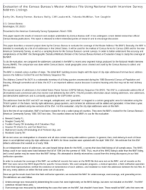Evaluation of the Census Bureau's Master Address File Using National Health Interview Survey
Evaluation of the Census Bureau's Master Address File Using National Health Interview Survey
This paper describes a research project done by the Census Bureau to evaluate the coverage of the Master Address File (MAF). Basically, the MAF is intended to eventually be a list of all addresses in the United States. It will be used for the mailout of Census forms for Census 2000 and for the new American Community Survey, as well as a sampling frame for the Census Bureau’s current surveys. In order to better understand the accuracy and completeness of the MAF, the Demographic Statistical Methods Division of the Census Bureau formed an Evaluation Group to study the coverage of the MAF.
To do the evaluation, we compared the addresses contained in the MAF to recent area segment listings produced for the National Health Interview Survey (NHIS). The comparison was done within Census blocks, small geographic areas created and used by the Census Bureau to collect and tabulate data.
The MAF is created using a number of steps. The initial MAF building process begins with the input of city-style addresses from two basic address sources-the Address Control File and the Delivery Sequence File.
The Address Control File (ACF) is a nationwide inventory of all living quarters enumerated during the 1990 Decennial Census of Population and Housing. Although somewhat out-of-date, the ACF is an important address source because it contains housing units that may not be mail delivery points.
The second source of addresses is the United States Postal Service (USPS) Delivery Sequence File (DSF). The DSF is a nationwide address file of all residential and commercial units that receive mail delivered by the USPS. This file provides information about existing addresses, new addresses, and demolished addresses and is constantly updated by the USPS letter carriers.
The addresses from the DSF and ACF are merged, unduplicated, and "geocoded" or mapped to a certain geographic area for tabulation using the TIGER system. In the future, noncity style addresses, group quarters, and commercial addresses will be added and geocoded. A few times a year, the MAF will is updated using new versions of the DSF. For this evaluation, only the city style addresses were on the MAF.
Up to the time of our evaluation, MAFs had been created for only a select group of counties. They were the MAFs created for the Census Bureau’s American Community Survey 1996-1997 test sites. The counties where we had MAFs to use for the evaluation:
- Brevard County FL,
- Douglas County NE,
- Franklin County OH (including all of Columbus City),
- Houston TX (Harris Co. and Fort Bend Co.),
- Multnomah County OR (including all of Portland City), and
- Rockland County NY.
All six test areas are metropolitan in character and all sites contain county wide address systems. In general, then, mail delivery in each of these areas is accomplished using city-style addresses. All MAFs for these counties were updated with the April 1996 DSF. We estimate that this DSF reflects addresses that existed as of early 1996.
As an independent source of addresses, we used keyed listings done for the NHIS, a survey that does field listings of all sample areas. The NHIS listings used in our study were listed between the fall of 1994 and the summer of 1996. Thus, much of the NHIS listing is older than the MAF listing, and a small portion may be newer than the MAF listings. We attempted to identify mismatches caused from this timing discrepancy in our field verification operation.
In order to evaluate the coverage of the MAF, we verified all records that were on the NHIS file that were not on the MAF, and all records on the MAF that were not on the NHIS keyed file for specific Census blocks. We used computer programs, a clerical operation, a field verification operation in which field representatives verified the existence or nonexistence of each address, and resolution to match the addresses between the two files. In this way, every address on either file had some sort of outcome. Once we got the results back from the field verification operation, we evaluated the MAF for undercoverage, overcoverage, and geocoding errors. The definitions we used follow.
- Undercoverage was measured by determining the cases that were legitimately on the NHIS listings, but were not included on the MAF. The MAF somehow missed these units.
- Overcoverage was measured by determining the cases that were on the MAF, but shouldn’t have been. These would be MAF units that were not on the NHIS listings or found during field verification, and should therefore not be included.
- Geocoding errors were measured for the MAF only. These were records that had an incorrect tract or block code on the MAF. Units that were on both MAF and NHIS were not checked for geocoding errors. Therefore, this number could be under representing the true percentage of geocoding errors.
Others in Series
Working Paper
Working Paper
Working Paper






